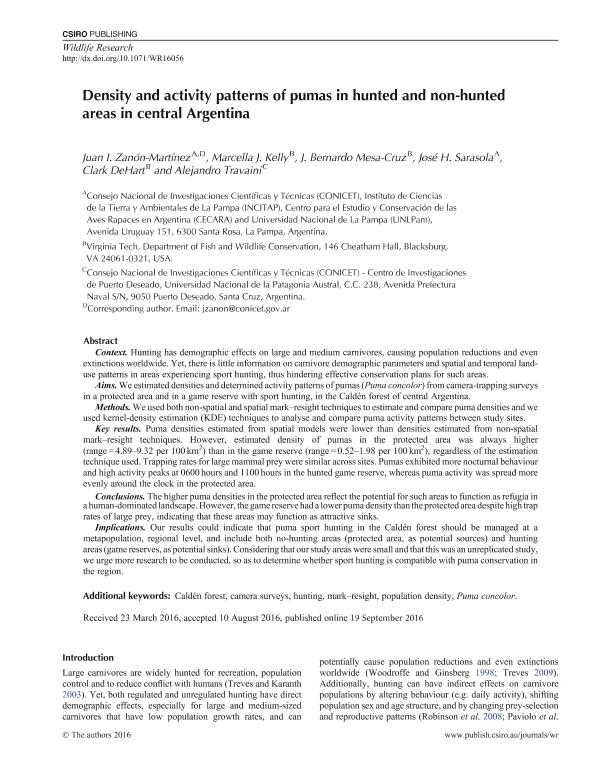Artículo
Density and activity patterns of pumas in hunted and non-hunted areas in central Argentina
Zanón Martínez, Juan Ignacio ; Kelly, Marcella J.; Mesa Cruz, J. Bernardo; Sarasola, José Hernán
; Kelly, Marcella J.; Mesa Cruz, J. Bernardo; Sarasola, José Hernán ; DeHart, Clark; Travaini, Alejandro
; DeHart, Clark; Travaini, Alejandro
 ; Kelly, Marcella J.; Mesa Cruz, J. Bernardo; Sarasola, José Hernán
; Kelly, Marcella J.; Mesa Cruz, J. Bernardo; Sarasola, José Hernán ; DeHart, Clark; Travaini, Alejandro
; DeHart, Clark; Travaini, Alejandro
Fecha de publicación:
09/2016
Editorial:
Csiro Publishing
Revista:
Wildlife Research
ISSN:
1035-3712
Idioma:
Inglés
Tipo de recurso:
Artículo publicado
Clasificación temática:
Resumen
Context. Hunting has demographic effects on large and medium carnivores, causing population reductions and evenextinctions worldwide. Yet, there is little information on carnivore demographic parameters and spatial and temporal landusepatterns in areas experiencing sport hunting, thus hindering effective conservation plans for such areas.5 Aims. We estimated densities and determined activity patterns of pumas (Puma concolor) from camera-trapping surveysin a protected area and in a game reserve with sport hunting, in the Caldén forest of central Argentina.Methods. We used both non-spatial and spatial mark?resight techniques to estimate and compare puma densities and weused kernel-density estimation (KDE) techniques to analyse and compare puma-activity patterns between study sites.Key results. Puma densities estimated from spatial models were lower than densities estimated from non-spatial10 mark?resight techniques. However, estimated density of pumas in the protected area was always higher(range = 4.9?9.32 per 100 km2) than in the game reserve (range = 0.52?1.98 per 100 km2), regardless of the estimationtechnique used. Trapping rates for large mammal prey were similar across sites. Pumas exhibited more nocturnal behaviourand high activity peaks at 0600 hours and 1100 hours in the hunted game reserve, whereas puma activity was spread moreevenly around the clock in the protected area.15 Conclusions. The higher puma densities in the protected area reflect the potential for such areas to function as refugia ina human-dominated landscape. However, the game reserve had a lower puma density despite high trap rates of largeprey, indicating that these areas may function as attractive sinks.Implications. Our results could indicate that puma sport hunting in the Caldén forest should be managed at ametapopulation, regional level, and include both no-hunting areas (protected area, as potential sources) and hunting20 areas (game reserves, as potential sinks). Considering that our study areas were small and that this was an unreplicated study,we urge more research to be conducted, so as to determine whether sport hunting is compatible with puma conservation inthe region.
Palabras clave:
Caldén Forest
,
Camera Surveys
,
Population Density
,
Puma Concolor
Archivos asociados
Licencia
Identificadores
Colecciones
Articulos(INCITAP)
Articulos de INST.D/CS D/L/TIERRA Y AMBIENTALES D/L/PAMPA
Articulos de INST.D/CS D/L/TIERRA Y AMBIENTALES D/L/PAMPA
Citación
Zanón Martínez, Juan Ignacio; Kelly, Marcella J.; Mesa Cruz, J. Bernardo; Sarasola, José Hernán; DeHart, Clark; et al.; Density and activity patterns of pumas in hunted and non-hunted areas in central Argentina; Csiro Publishing; Wildlife Research; 43; 6; 9-2016; 449-460
Compartir
Altmétricas



